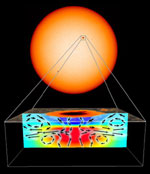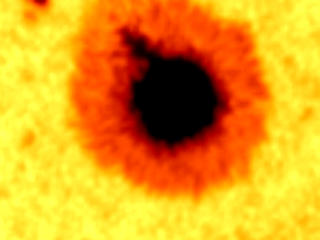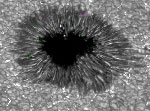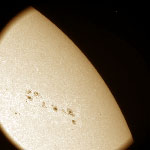|
What Lies Beneath a Sunspot |
Image 1 caption:This image is an artist's concept of
that lies beneath sunspots, enigmatic, planet-sized
dark areas on the surface of the Sun. The bottom
close-up is a cross section revealing the hidden
structure of a sunspot.
The intense magnetic field below a sunspot strangles the
normal up-flow of energy from the hot solar interior,
leaving the spot cooler and therefore darker than its
surroundings (dark blue region in the cross-section
image). The suppression of the bubbling convective
motions forms a kind of plug that prevents some of the
energy in the interior from reaching the surface.
As a result, the material above the plug cools and
becomes denser, causing it to plunge downward at up to
3,000 miles per hour, according to new observations
from the Solar and Heliospheric Observatory (SOHO)
spacecraft. That draws the surrounding electrified gas
(plasma) and magnetic field inward toward the sunspot's
center. The concentrated field promotes further cooling,
and as that cooling plasma sinks it draws in still more
plasma, thereby setting up a self-perpetuating cycle.
These plasma flows are represented by the black arrows
near the top of the cross-section image, in and around
the cool, dark blue region. As long as the magnetic field
remains strong, the cooling effect will maintain an inflow
that keeps the sunspot stable.
Since the magnetic plug prevents heat from reaching the
solar surface, the regions beneath the plug become
hotter, which is represented by the red area beneath the
blue region in the cross section image. The cool
downward flows dissipate at the same depth where the
hot upward flows diverge, as shown by black arrows in
and around the red area.
IMAGE CREDIT: NASA / ESA Image 1 in black and white Image 1 high-res color |
|
Scientists now have the first clear picture of what lies beneath sunspots, enigmatic planet-sized dark areas on the Sun's surface, and have peered inside the Sun to see swirling flows of electrified gas or plasma that create a self-reinforcing cycle, which holds a sunspot together. The new research, gathered from the Michelson Doppler Imager (MDI) onboard the Solar and Heliospheric Observatory (SOHO) spacecraft, will deepen understanding of the stormy areas on the Sun in which sunspots appear. Vast explosions associated with these active magnetic regions occasionally affect high-technology systems. Sunspots have fascinated people since Galileo's observations of them contradicted the common belief that heavenly objects were flawless. Sunspots remain mysterious because at first glance, it seems they should rapidly disappear. Instead, they persist for weeks or more. "They obey what is a fundamental finding of observational science: Anything that does happen, can happen," said Philip Scherrer of Stanford University, Palo Alto, Calif., Principal Investigator for SOHO's MDI. "We now have a hint at 'how.'" | |
|
Under the Sunspot movie |
Image 2 caption: Why are sunspots so much cooler
than the solar surface (photosphere)? Thanks to a
method similar to an ultrasound, scientists found much
hotter temperatures below the spot that seem to get
trapped by magnetic fields forming a virtual bottleneck,
making the spot much cooler than the surface. In the
visualization, completely created from data of a June
1998 sunspot; red is hottest, followed by yellow; purple is
cold.
CREDIT: NASA |
|
Astronomers know sunspots are regions where magnetic fields become concentrated. Yet, anyone who played with magnets as a child has felt how magnetic fields of like polarities repel each other. The strong solar magnetic fields should naturally repel each other also, causing the sunspot to dissipate. In fact, observations show that surface material clearly flows out of the spots. Alexander Kosovichev and Junwei Zhao of Stanford University and Thomas Duvall of NASA's Goddard Space Flight Center, Greenbelt, Md., used MDI's unique ability to look just below the sunspot's surface and clearly observed inward-flowing material for the first time. The Astrophysical Journal published their research August 10. | |
|
Internal
Ebb and Flow movie |
Image 3 caption: How do sunspots remain intact with
opposite magnetic fields repelling each other? For the
first time, scientists were able to confirm theories that
inward flows of material stabilize the structure. With the
MDI instrument, scientists observed the flows, seen here
in an animation based on the June 1998 sunspot.
CREDIT: NASA / MDI |
|
"We discovered that the outflowing material was just a surface feature," said Zhao. "If you can look a bit deeper, you find material rushing inward, like a planet-sized whirlpool or hurricane. This inflow pulls the magnetic fields together." Solar astronomers have long known that the intense magnetic field below a sunspot strangles the normal up-flow of energy from the hot solar interior, leaving the spot cooler and therefore darker than its surroundings. The suppression of the bubbling convective motions forms a kind of plug that prevents some of the energy in the interior from reaching the surface. | |
|
What
is a sunspot? |
Image 4 caption: Sunspots appear dark because they
are cooler than the solar surface due to a strong
magnetic field that traps the core's heat from travelling to
the surface. The average sunspot is about 4500 degrees
C (8132 F), while the surroundings are about 6000
degrees C (about 10,000 F). Sunspots can last for weeks
or more and can be as large as 80,000 km (over 6
planet Earths). This image is from the Dutch Open
Telescope (DOT) resting atop a volcano on the island of
La Palma in the Canary Islands. The High-res link leads
to an image from the Big Bear Solar Observatory in
California.
CREDIT: DUTCH OPEN TELESCOPE / LOCKHEED MARTIN CREDIT FOR HIGH RES: BIG BEAR SOLAR OBSERVATORY / NJIT Image 4 in higher-res |
|
The material above the plug cools and becomes denser, causing it to plunge downward at up to 3,000 miles per hour, according to the new observations. That draws the surrounding plasma and magnetic field inward toward the sunspot's center. The concentrated field promotes further cooling, and as that cooling plasma sinks it draws in still more plasma, thereby setting up a self-perpetuating cycle. As long as the magnetic field remains strong, the cooling effect will maintain an inflow that makes the structure stable. The superficial outflows seen right at the surface are confined to a very narrow layer. Since the magnetic plug prevents heat from reaching the solar surface, the regions beneath the plug should become hotter. A June 1998 observation provided evidence for this also. "We were surprised at how shallow sunspots are," said Kosovichev. Below 3,000 miles the observed sound speed was higher, suggesting that the roots of the sunspots were hotter than their surroundings, just the opposite of the conditions at the surface. "The cool part of a sunspot has the shape of a stack of two or three nickels," he added. | |
|
Galileo's
Sunspots |
Image 5 caption: Galileo Galilei was one of the first
Europeans to study and record sunspots in 1611.
Contrary to other theories, he believed that sunspots
were part of the Sun itself, like spots or clouds. This was
controversial because popular sentiment, based on the
likes of Greek philosopher Aristotle, was that the Sun
and heavens were perfect and unblemished.
CREDIT: GALILEO PROJECT, RICE UNIVERSITY / OWEN GINGRICH |
|
"The cool downward flows dissipate at the same depth where the hot upward flows diverge," said Duvall. "With these data one cannot get a sharp enough picture to really explain the details. Until now we've looked down at the top of sunspots like we might look down at the leaves in treetops. For the first time we're able to observe the branches and trunk of the tree that give it structure. The roots of the tree are still a mystery." MDI explores beneath the surface of the Sun by analyzing sound-generated ripples at its surface using a technique called acoustic tomography -- a novel method similar to ultrasound diagnostics in medicine that use sound waves to image structures inside the human body. SOHO continues to mark an era of successful partnership between the European Space Agency and NASA within the Solar Terrestrial Science program. | |
|
TRACE
Coronal Loops TRACE
satellite image TRACE
satellite image |
Images 6, 7, and 8 caption: What is happening above
the sunspot? The Transition Region and Coronal
Explorer (TRACE) spacecraft caught these coils of hot,
electrified gas, known as coronal loops above active
sunspots. The loops (some more than 300,000 miles
high and capable of spanning 30 Earths) rise while
flowing along the solar magnetic field, then cool and
crash back to the surface at more than 60 miles per
second (100 kilometers per second).
CREDIT: NASA / STANFORD LOCKHEED INSTITUTE FOR SPACE RESEARCH TIFF resolution of Image 6 |
Click here to view more SVS images on the SOHO's view of the Sun in 1998 projected onto a sphere.
Click here to view more SVS images on the SOHO's view of the Sun in 1998 projected onto a flat plane.
Click here to view more SVS images on the SOHO's view of the Sun in 2001 projected onto a sphere.
Click here to view more SVS images on the SOHO's view of the Sun in 2001 projected onto a flat plane.
Click here to view Stanford's information on "SOHO's MDI shows view beneath sunspots".
Click here to view more information from Goddard on sunspots.







